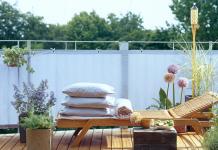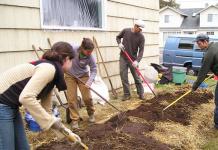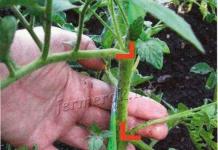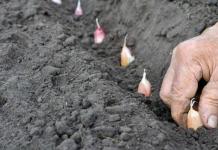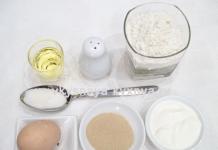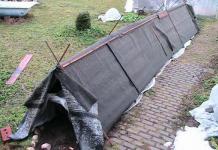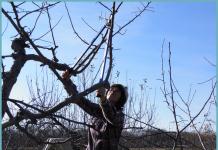Lemon Tree- perennial evergreen cultivated plant which grows in subtropical climates. Frosts lemon does not tolerate well, but in favorable conditions it grows year-round and bears fruit several times a year. Fruits of the same variety ripen at different times of the year (there are summer, autumn and winter lemons) and differ in appearance and chemical composition... In our latitudes, this culture is not grown in open ground due to unsuitable climatic conditions for it. But dwarf varieties (up to 3 m in height) can be grown in greenhouses or in an ordinary tub in an apartment.
BREEDING AND LANDING
For growing lemon at home, it is better to choose varieties with a compact crown, for example, Pavlovsky, Novogruzinsky, Meyer and others. Propagated by lemon seeds or vegetatively, by rooting lignified cuttings.
Seed propagation is technically simpler than cuttings, but remember that the seedling does not inherit the characteristics of the parent plant. Also, a tree grown from a seedling begins to bear fruit in the 8-10th year after planting (while lemons grown from rooted cuttings - in the 3rd). Of course, the seedling can be grafted with varietal lemon and the harvest can be accelerated by several years.
The main advantages of seed reproduction - the quality of the plant itself, it is unpretentious, grows well, gets sick less, adapts better to adverse conditions, and is also more powerful and beautiful than a seedling grown from a cuttings.
To obtain seeds, several healthy, fully ripe fruits of the same variety are taken at once. The seeds are sown immediately after they are removed from the lemons, so it is better to prepare planting boxes or pots in advance. Drainage is poured at the bottom of the planting containers, then a soil mixture of peat and soil for flowers in a 1: 1 ratio. Before planting, seeds can be treated with a growth stimulant, for example, soaked for a day in a solution of sodium humate - this will accelerate the formation and growth of the root system in the future.
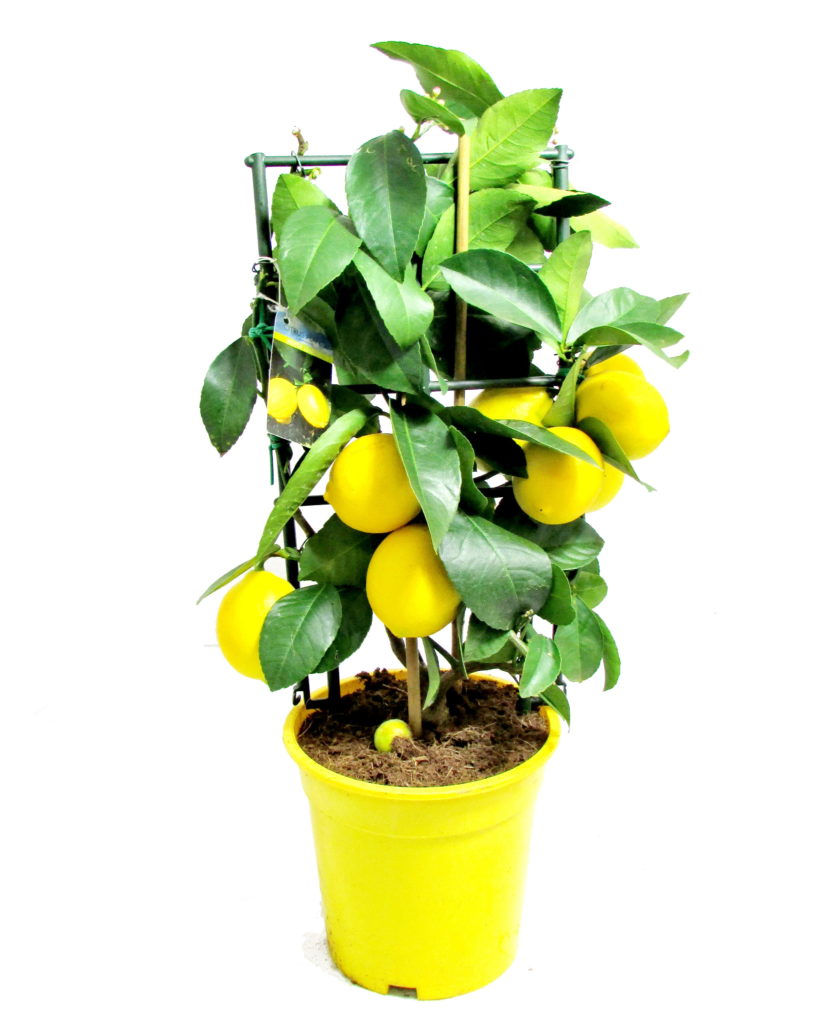
When planting, seeds are placed at a distance of 3 cm from each other, to a depth of 2 cm - buried below, they can suffocate under a layer of soil, and above they dry out. Maintain constant soil moisture and a temperature of 22 ° C.
Seedlings will appear in a couple of weeks. They are grown under indirect sunlight, covered with a glass jar or cap - to create a microclimate. Once a day, the jar is removed to ventilate the sprouts.
After the sprouts a pair of real leaves will appear, they, together with a lump of earth, while maintaining the integrity of the roots, are transferred into ceramic pots of a larger volume (up to 10 cm in diameter) - each into a separate container. When the seedlings reach 15-20 cm in length, they are transplanted again into a "permanent" container.
![]()
For propagation of lemon by cuttings they are cut from the lignified branches of last year's growth (length up to 10 cm, 4-5 mm in diameter), when rooting in the fall - from the spring growth, however, it is not recommended to do cuttings in the fall due to the low survival rate of plants. It is best to graft lemons in March-April. The branches are cut slightly obliquely, the place of the cut is immediately covered with garden var. Each branch is cut into cuttings so that each has 3-4 formed eyes and 2-3 leaves.
Slices should be done at a distance of 3-4 mm from the upper and lower kidneys. The resulting cuttings are soaked for a day in a solution of heteroauxin (0.1 g per 1 liter of water), tying them into bundles of 10 pcs. and immersed in a solution of 2 cm. Then they powder the lower part of the cuttings with crushed charcoal and start planting.
They are planted in a mixture of humus, coarse sand and flower soil (1: 1: 1), before planting the soil is compacted, then with a pointed stick they make holes in it 3 cm deep, given that the feeding area of one cutting is 5 × 5 cm. The cuttings are planted in the holes to the depth of the second eye, the soil around the holes is squeezed. Immediately spray the cuttings with warm water.
Box-greenhouse cover with a glass cap, removing it several times every day for ventilation for 10 minutes, and lighting up. Until the roots appear and the plant is unable to extract moisture from the soil on its own, the leaves are sprayed 3-4 times daily. The optimum air temperature in the rooting room is 25 ° C. After a month and a half, the cuttings will take root and the plants can be transplanted into larger pots.
To do this, drainage from expanded clay and charcoal is laid in ceramic containers, then a layer of coarse river sand (1 cm), and on top - nutritious flower soil (2 cm). The cuttings are carefully pry up and taken out of the box with a lump of earth. They are planted to a depth of 1 cm and watered in several steps until all the soil in the container is wet. The pots with plants are placed in a shaded place for 10 days, and then gradually moved closer to the light.

CARE AFTER LANDING
In order for the lemon tree to grow well, not hurt and bear fruit, it needs to create favorable conditions. The air temperature in the room, which is comfortable for him, is from 18 to 27 ° С. Lemon does not tolerate drafts, direct sunlight and dry air. Having chosen a convenient place for a pot with a tree, try not to move it - the pot can only be carefully rotated around its axis so that the plant, directing the growth of branches to the light source, forms the correct crown. Lemon must be constantly sprayed with a spray bottle or a humidifier should be placed next to the pots.
In summer, the plant is watered twice a week, in the cold season, watering is reduced, making sure that the soil in the pot does not dry out. Watering is desirable with settled or melted water at room temperature. The plant also needs feeding (with complex mineral and organic fertilizer, it is best to use a special fertilizer for citrus fruits), in the summer they are fed once every 10 days, in the winter - once a month.

If possible, trees are also additionally illuminated with ultraviolet rays, especially in winter period... With proper care, the lemon will bloom a few years after planting. In order for the fruits to set at home, he needs to help with pollination - with a cotton swab, transfer a little pollen from the pistil to the stamen. The number of ovaries must be normalized - one fruit per 10-15 leaves, if there are many fruits, the plant will be depleted and may die.
Lemon tree at home, pruning and shaping is also necessary. In the first year of life, 1 shoot appears up to 30 cm in height. In the second year, before the start of active growth, it is cut off at a height of 20 cm, leaving four well-developed buds, from which 3-4 skeletal shoots (first order) are formed. When they reach 30 cm in length, they are pinched. Shoots of the second order are cut by 20-25 cm. Subsequent shoots should be 5 cm shorter than the previous ones. The formation of the crown is completed on the shoots of the fourth order.
Fruiting plants are pruned to remove old, malformed, or thickening shoots. This is best done in March or winter after harvest. A short pruning causes the emergence of new strong shoots, and a long pruning stimulates the formation of fruit buds.
When caring for the crown, you can use pinching, plucking out excess shoots, and in some - the tops after the appearance of 5 leaves.
They say that from any sour lemon destined by fate, you can make a sweet lemonade. But lemon is good even without added sugar - a noble, fragrant healing fruit, all parts of which are used as food, except for seeds. But they can be used to grow new lemon trees. So if fate gives you a lemon, thank her for this wonderful gift.
28.09.2016
23 114
How to care for lemon at home - a cheat sheet for housewives
When growing an exotic plant in an apartment, you need to know how to care for a lemon at home. The tree is capricious enough to get a tasty harvest, it takes a lot of time and effort for the long-awaited result. Only the observance of certain rules will make the lemon bear fruit and please with healthy growth.
Content:
What conditions do indoor lemon need?
Many growers decide, others buy the plant in the store, but the caring measures for citrus fruits are almost the same. When choosing a place for a lemon in an apartment, keep in mind that the tree does not like the constant movement from corner to corner. The plant is placed farther from the heating devices, but closer to the window - sometimes the task is difficult to do, since in many apartments the batteries are located directly under the window.
Lemon needs light for good growth and proper development, best of all diffused light in the south side of the house, as the plant belongs to the citrus fruits of short daylight hours. Some gardeners keep the citrus tree exposed to sunlight for no more than two hours a day. In order to take care of lemon in winter correctly and correctly, provide additional lighting, for example, using lamps for seedlings (fluorescent, sodium, etc.), no more than 5-6 hours a day.
Lighting plays important role when caring for indoor lemon, the leaves literally unfold after the sun's rays. Rotate the pot clockwise as needed to make the tree look beautiful from all sides. It is worth noting that too abundant and prolonged exposure to the light (more than 12 hours) leads to a very active growth of the tree, which stretches out. Lack of illumination inhibits growth processes.
The main care for a lemon in a pot begins in spring, when the plant begins to build up vegetative mass, bloom, and then bear fruit. Compliance temperature regime it is extremely necessary, the range of good growth is within the range of +15 ° ... + 27 ° C., while the temperature should be constant, without sudden jumps.
 in the photo - lemon at home
in the photo - lemon at home
During the flowering period of home lemon, provide a temperature of +18 ° C in the apartment, no more. An increase in the degree leads to drying out of inflorescences and dropping of buds. In the spring, a blooming lemon can be taken out to the loggia, balcony, if conditions permit. A pot of lemon should be placed on an open area carefully so that the plant does not freeze.
Caring for homemade lemon in winter requires a cooler temperature than in spring and summer, since intense heat can provoke the development of various diseases, in some cases the death of the entire tree. Humidity is maintained at 60-70%. In dry, hot conditions, citrus is sprayed with a spray bottle twice a day.
Top dressing and watering homemade lemon
Particular attention should be paid to watering the lemon, especially during the period of vegetative growth, budding, flowering. Under normal conditions, the tree can actively grow, bloom, and bear fruit all year round. In summer, lemon is watered abundantly and daily. Water should protrude on the pallet, which is then absorbed by the plant if irrigation was not plentiful.
The water temperature for watering citrus fruits should be at least room temperature, preferably a couple of degrees higher. It is better to irrigate in the evening, since evaporation slows down at this time, water is consumed by plants more efficiently.
Experienced flower growers temporarily dry the lemon to stop flowering, so that the formation of buds takes place at a certain time. This is due to the fact that the process from the formation of peduncles to the ripening of fruits lasts differently (7-12 months), but if the lemon blooms in summer, the fruits ripen 1.5-2 months earlier than in spring flowering.
To dry the lemon tree at home, i.e. before the leaves begin to wither, it is necessary to stop watering, then the plant will go into forced dormancy and show rapid growth and flowering with the resumption of watering. The tree can be grown in the same land for several years, therefore, in the first 3-4 years (sometimes more), the lemon is not transplanted, since there is no need.

Fertilizing the lemon tree is very important as citrus is cultivated in a confined space. If the lemon is grown from seeds, remember that the root system of such a tree is very delicate and improper feeding, combined with high soil moisture, leads to homoz. Be careful, as the roots are easily damaged when using mineral fertilizers.
Flaw nutrients leads to wilting, yellowing of the leaf apparatus, poor flowering, shedding of buds, little or no fruiting. When to fertilize lemon? Firstly, during the period of budding, fruit setting, and secondly, with visible deficiencies of nutrients in the plant.
When caring for a lemon, you need to remember that the tree has an increased growth period 3-4 times a year. To get a harvest, you need to regularly feed citrus. Usually, abundant flowering occurs from February to August. In winter, the amount of dressing is reduced to once a month.
Lemon fertilizing during the flowering period, exactly as during fruiting, is done once every two weeks. It is better to feed the indoor lemon with organic matter. Well suited, for example, Gumi Omi Kuznetsova Lemon, the drug is basically natural, so it can be used for home tree... Dilute 1 tbsp. fertilizer in a liter of water, mix well, pour 0.5 cups per plant (more volume is required for mature powerful trees). You can use another natural preparation Lemon-Mandarin "Mother Earth".
Lemon fruiting at home cannot be achieved without top dressing, neither in the spring nor in the summer. It is also recommended to spray the underside of the leaves with a fertilizer solution. Fertilizing citrus fruits after transplanting is carried out after 3-4 weeks, the main dose is given before placing the tree in a new container for 2-3 days. After transplanting the lemon into a new pot, it is recommended to water the plants with Cornesil to improve and restore the root system.
Diseases and pests of lemon, the fight against them
In poor conditions, lemon can be affected by pests, various diseases of an infectious and fungal nature. The main damage is caused by ticks. Red and silver mites are most present on lemon, which is grown in indoor conditions in the south of the country. The spider mite is known to everyone and is most common, both in the middle latitudes and in the north, where plants are in the apartment all year round, without the possibility of taking them out into the fresh air.
Spider mites are brown in color, sometimes with a red or yellow tint. With a close inspection of the plants, the pest is easy to spot. Usually hordes of pests are located on the underside of the leaves, braiding the green mass of the tree with the thinnest cobweb. Over the summer, one female can leave up to 10 generations, laying 150 eggs at a time.
The fight against spider mites on lemon is carried out using a soap solution, which is used to treat leaves and branches. Do not forget about rinsing the crown with a regular shower (the leaves are washed on both sides). Place the lemon pot away from other plants. Use a garlic infusion, pour 5-6 chopped cloves with a glass of boiling water, leave for 48 hours and sprinkle with lemon. If the plant is severely affected, insecticidal preparations are used (Omite, etc.).
 in the photo - a harvest of homemade lemon
in the photo - a harvest of homemade lemon
The scabbard can also become a nuisance guest that damages the citrus leaves. On the back of the leaves, sometimes on the stems, you can find clusters of small brown scales, which practically do not separate from the plant. It is necessary to deal with the scabbard immediately, otherwise the defeat of the leaf apparatus will lead to leaf fall, fruiting may slow down. Methods for dealing with the scale insect on lemon are similar to those for aphids.
In addition to nasty pests, lemon can suffer from diseases such as:
- root rot is mainly found when leaves begin to fall off en masse. Here it is necessary to transplant into a new pot with good rinsing of the roots and removal of rotten ones;
- gommosis destroys the trunk of a homemade lemon. In the lower part, browning of the bark and the formation of cracks are noticeable, from which a glue-like liquid of dark color is released. The size of the cracks gradually increases, and the decay process begins. Citrus urgently requires a transplant into a new soil with obligatory processing of the trunk copper sulfate, in difficult cases - the heavily affected bark is first cleaned off, then coated;
- malsecco is known for its defeat of shoots, sometimes to complete death. The disease begins at the tips of the branches, spreads to the leaves, trunk. Damaged parts will be painted brick. The disease has various forms, sometimes the lesion starts from the root system, as a result, the citrus dies very quickly. Unfortunately, currently there are no specific drugs and methods that can destroy the strain of the fungus. Observe preventive measures, if signs are found, treat infected areas of the plant with copper sulfate.
Many lovers of indoor floriculture would like to grow a lemon in an apartment, but the task seems difficult to them, doubts arise: whether the fruits will grow and whether they can be eaten.
Having learned all the intricacies of how a young lemon from a seed at home growing is gradually formed into a full-fledged fruit tree with a wonderful aroma and healthy, tasty fruits, some growers may well decide to grow citrus.
Other overseas fruits also sprout from the seed.
Preparing for the cultivation process and sowing lemon seeds
You need to try to have all the necessary accessories by the time of landing:
- It is best if the seeds are placed in small, store-bought ceramic pots. Environmentally friendly, breathable material will allow the bones, and in the future, young sprouts feel comfortable. You can use other suitable containers.
- It should be purchased in horticultural departments or compose soil for planting yourself, prepare material for the drainage layer.
- Now you can search in the market or ask friends who grow lemon trees for large and healthy fruit specimens.
- For the planned planting, the most suitable time is the end of winter. The gradually increasing length of the day will have a beneficial effect on the development of trees.
 Cut the lemons so that the seeds are not damaged, take them out and select several of the largest, regular shapes. Without waiting for them to dry, they are placed in a moistened soil at a shallow depth, sprayed with warm water from a spray bottle. Spraying, rather than watering, will help prevent seed rot.
Cut the lemons so that the seeds are not damaged, take them out and select several of the largest, regular shapes. Without waiting for them to dry, they are placed in a moistened soil at a shallow depth, sprayed with warm water from a spray bottle. Spraying, rather than watering, will help prevent seed rot.
From above, the pots or bowls are covered with glass or film, put in a bright place with a temperature of 22-24 degrees.
If the room where the planted lemons are located is below 18 ° C, the seeds will harden, mold and will not sprout. Under favorable conditions, the first shoots will appear in 2-3 weeks.
Home care for lemon seed sprouts
Growing lemon at home in a pot does not require much hassle:

Before the pick, the ground is periodically moistened with warm, settled water, fertilizers are not used. When 3-4 leaves are formed, the seedlings are prepared for picking.
Picking seedlings and further growth of lemon in a pot
If possible, it is best to continue growing lemons in appropriately sized clay pots. A few hours before planting, they are soaked in water, then the bottom is covered with a layer of drainage, and nutrient soil of the same composition that was used for planting is poured on top.
They carry out a kind of selection work to select the best seedlings, paying attention to the following criteria:

Selected specimens are planted in pots, watered a little to compact the soil in the root zone, and placed on the eastern or western windowsill.
Until the next transplant, a year later, the plants are watered, fertilized with mineral and organic nutrient mixtures, alternating between them.
Do not forget to spray the crown daily, the tree needs high humidity.
In the first year of a young tree's life, when it reaches a height of about 20 cm, they begin to form the crown.
Proceed as follows:

The impatience of the gardener waiting for the first harvest is understandable, but experienced lemon breeders advise to cut off the flowers that have appeared so as not to overload the root system of the young plant. Shoots growing inside the crown are also removed.
How to grow lemon from cuttings at home?
This method of growing is easier and will allow you to wait for the harvest faster than when planting seeds, besides, the yield of such trees is higher. Cutting is best done in the last winter or early spring days.
Cuttings are taken from a home-grown fruit-bearing tree, which is at least 7-10 years old. On the branches of the 4th or 5th order, they look for slightly lignified shoots, cuttings about 15 cm long, no more, are cut from them under the bud.
The upper cut of the cutting is made above the bud, the lower leaves are removed, glorifying 2-3 leaves and 3-4 buds, the upper leaf is left intact, the rest are cut to 1/3 of the length.
 The lower cut of the cuttings is dipped into clean water or a solution of a rooting stimulant and incubated for 3 days. Then they are placed in pots with a nutrient mixture consisting of flower soil, humus, coarse sand, to a depth of 3 cm. Cover with a film, creating the effect of a greenhouse.
The lower cut of the cuttings is dipped into clean water or a solution of a rooting stimulant and incubated for 3 days. Then they are placed in pots with a nutrient mixture consisting of flower soil, humus, coarse sand, to a depth of 3 cm. Cover with a film, creating the effect of a greenhouse.
Growing a lemon from a cutting at home is to sprinkle it with warm water several times a day. The cuttings do not have a root system; they need to be provided with moisture by spraying and maintaining soil moisture.
The temperature must be maintained at the optimum level for planting, from 23 to 25 degrees. Direct rays of the sun can damage future trees; southern windowsills are not suitable for them.
Picking rooted lemon cuttings
If proper care has been taken, after a month and a half, the cuttings will develop a root system, they can be transplanted into separate pots.
Some experienced flower growers prefer to prepare the soil for planting lemon on their own, mixing:

The composition is mixed, moistened, poured into pots. The mixture is tamped a little, a hole is made, a cutting is placed in it.
Pour warm water to compact the earth, trying not to overflow. Every 10 days, the plant is turned, exposing the sun to different sides so that the development is uniform.
Home care for lemons
Lemons are long-day plants, in early spring, when the days are still short, they need artificial lighting.
Young seedlings are transplanted 1-2 times a year, the older the plant, the less often transplants should be, so that the roots are not damaged and the symbiosis of roots with mycorrhiza, a fungal substance necessary for citrus trees, is not disturbed. When the mycorrhiza dies off, the young branches of the plant begin to blacken.
 To ensure that growing lemons on the windowsill does not bring disappointment, you need to carefully monitor the irrigation schedule and the quality of the water used. Do not overmoisten the soil and allow it to dry out.
To ensure that growing lemons on the windowsill does not bring disappointment, you need to carefully monitor the irrigation schedule and the quality of the water used. Do not overmoisten the soil and allow it to dry out.
With mandatory feeding, which begins in spring, the main principle is that it is better to underfeed, lemons react hard to. It is recommended to use special fertilizing mixtures: "Citrus", "Lemon" and others like that.
The changing color of the leaves, indicating a lack of one of the nutrients, should not escape the attention of the gardener. Having discovered the problem in time, they take action by feeding the tree with the missing substance.
Visual instructions for growing lemon at home
This video will tell you in detail about the features of planting and caring for lemon trees at home:
Planting and growing lemon from cuttings
You can grow a lemon tree on your own in several ways, the simplest ones are sowing seeds and rooting a cuttings. To get the fruits as soon as possible, it is recommended to use the second method. When growing a tree from a cutting, it begins to bear fruit as early as the 3rd or 4th year of life, and from a seed - 4–5 years later. In this case, the cutting inherits all the characteristics inherent in the mother plant, while working with seed material is more suitable for breeding.

How to plant a lemon using the cuttings method? Suitable for planting only healthy shoots 8.5-10 cm long, with large, well-developed leaves and buds in the amount of three, and preferably four pieces. The lower cut is made a few millimeters from the kidney and at an angle of 90 degrees. Upper - at a distance of 4-6 mm from the last kidney, the cut should be at an angle of 45 degrees. To prevent the bottom sheet from rotting, it is recommended to cut it off. The mother plant from which the cuttings were taken must be strong, healthy and already bearing fruit. The best time for rooting the cuttings is from the first days of April to the end of June.
The rooting substrate is prepared as follows. As a nutrient mixture, a special citrus soil is suitable, which can be obtained from the horticultural department. The manufacturer has already taken care of its disinfection, so the soil packed in vacuum bags is not processed. Also, the grower will need river sand of the middle fraction; before using it, it will need to be thoroughly rinsed in cold running water, and then calcined for 7-10 minutes in the oven. It is important that pathogens and pathogenic bacteria do not get into the substrate.
![]()
How to plant a lemon (stalk) in the substrate? First you need to prepare a box for planting. It should be large enough and equipped with several staggered drainage holes. It is better to take cuttings with a margin in case some of them die at the seedling stage. The substrate is placed in the box as follows:
- drainage (fine expanded clay, shards, pieces of foam) - a layer of 3-5 cm,
- soil mix for citrus fruits,
- sand - a layer of about 5 cm.
Before planting, the cuttings can be treated with a rooting stimulant. The exposure time in the solution depends on the selected drug and the recommendations in the attached instructions. Immediately before planting, the slices are powdered with crushed charcoal to reduce the risk of developing fungal diseases.
The upper layer of the substrate (sand) is moistened and the cutting is planted to a depth of no more than 2.5 cm. In this case, the young roots, as soon as they get stronger, will immediately be able to consume nutrients from the earthen mixture under the layer of sand. After planting, the sand is carefully sprayed with a spray bottle, and the box is covered with glass or a transparent plastic "cap" is put on, simulating the conditions of a greenhouse. It is important that there is a free space of at least 5–7 cm between the glass and the top of the cutting. The container with the cuttings is placed by the window, but placed in such a way that the rays of the sun do not fall on them. Optimum temperature environment for early rooting - 22–25 ° C.
Features of growing a lemon seedling after planting
Knowing how to plant a lemon, the grower often has questions about further caring for it. To prevent seedlings from dying, you need to familiarize yourself with the peculiarities of their cultivation.

After planting the cuttings in the ground, the substrate is regularly sprayed and the top layer is not allowed to dry out. "Parnichok" needs to be ventilated periodically so that the stagnant moist air does not destroy the plant. The lemon will develop quite slowly, and it will not be necessary to transplant it into an individual pot earlier than in a month and a half. Young leaves or shoots will be a sign that the cutting has taken root and started growing. In order for the root system to develop faster, it is recommended to carry out top dressing. You can use ammonium nitrate (0.25%), which stimulates root formation well.
Before diving seedlings into individual containers, it is necessary to harden the plants. The glass or "cap" in the first days is removed for no more than 2 hours, then, the procedure time is increased to 4 hours. After 12-16 days, the shelter is completely removed, and the lemon is transplanted.

A young lemon sapling - how to plant it in a larger container? For growing growing and matured seedlings, a special substrate is prepared:
- sod land - 2 parts,
- leaf land - 1 part,
- rotted manure - 1 part,
- calcined river sand - 0.5 parts.
All components are thoroughly mixed, the earth is laid out in a container, at the initial stage, a pot with a diameter of no more than 12 cm is sufficient.Previously, a layer of expanded clay, pebbles or broken brick must be placed on the bottom of the container. Lemon seedlings are removed from the common box very carefully, digging in with a spoon or a small spatula so as not to damage the root system. In the first year of life, young lemons are transplanted 2 more times, choosing larger containers. During transplantation, the old earthen lump is not destroyed, so as not to injure the delicate tropical plant once again.
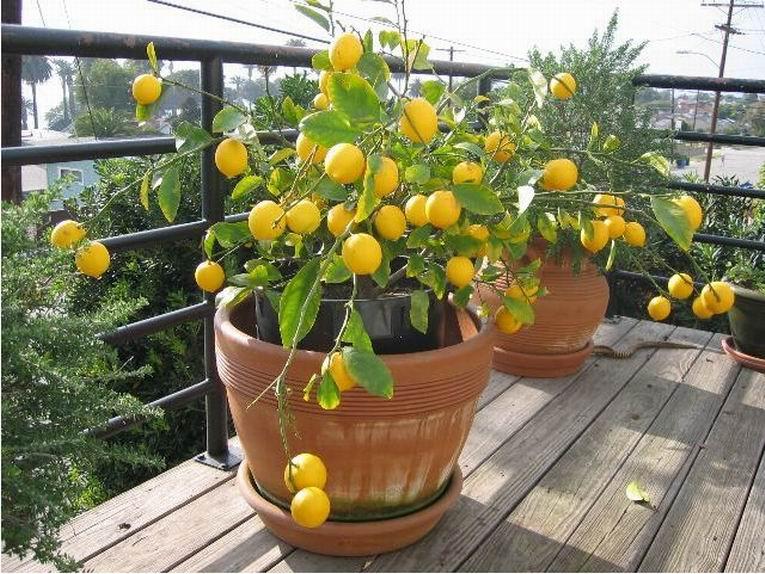
Further lemon transplant
Knowing how to plant a lemon, it remains to consider the technology of transplanting young and adult specimens. For the first 2-3 years, it is recommended to replant the plant up to three times a year, each time increasing the volume of the pot or tub by 4-8 cm, depending on the age of the tree. In this case, the substrate for adult specimens is slightly modified. Instead of river sand, muddy soil and superphosphate with ash are added at the rate of 100 g of substance per 10 kg of soil. The transplant is best done in the spring, and if necessary, at any other time of the year.
In the first days after transplanting, the plants should be shaded from direct sunlight by transferring the container to the north window, or covering it with sheets of cardboard and a thick fabric curtain. And lastly, adult specimens are transplanted only when the earthen lump is tightly entangled with roots, if this did not happen, then you should not injure the plant and it is desirable to postpone the procedure.

How to stimulate the fruiting of lemon?
Many gardeners, knowing how to plant a lemon and grow a beautiful tree from it, are faced with such a problem as the lack of flowers and fruits. A plant grown from a cuttings, under favorable conditions, should begin to bear fruit in the third, or even in the second year of life. When this does not happen, it may be that the lemon is lacking in nutrients or the conditions are not suitable for it. If the florist believes that care is provided properly, then flowering can be stimulated by grafting a branch from a fruiting specimen. In the event that there are flowers, but the fruits are not tied, you can try to pollinate the plant yourself with a cotton swab. It is worth making a little effort and the plant will certainly delight you with delicious and juicy fruits.
Video how to grow lemon
There is an opinion among gardeners that growing indoor lemon bearing fruit, the task is quite difficult. However, as practice shows, with proper planting and regular care, you can grow a fruiting tree at home in 4-5 years. It is known that the fruiting of citrus fruits grown from the seed occurs in 6-8 years. Plants obtained by grafting or grafting begin to produce crops much earlier.
The home-grown lemon shrub reaches a height of about 2 m, has smooth, dark green leaves with a characteristic citrus scent, a thin stem with dense reddish bark and many branches. Less common are individuals reaching up to 4 m in height, but it is rather difficult to care for them indoors. The lemon tree looks very attractive, therefore it serves not only for obtaining fruits, but also for decorating the room. V good conditions the plant blooms and bears fruit all year round.
How to plant a lemon from a stone: photo and description
One of the most common methods of reproduction of this culture is growing from a bone. How to plant a lemon seed (seed)?

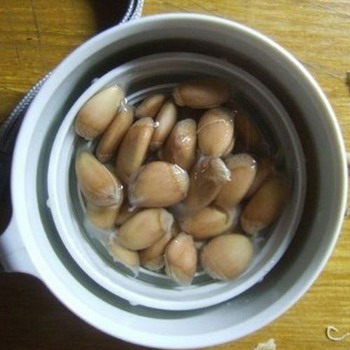
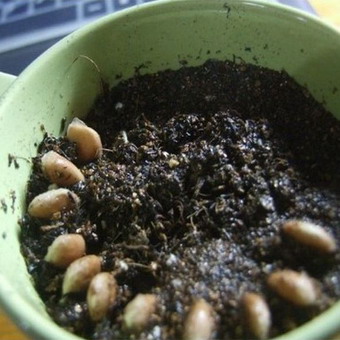
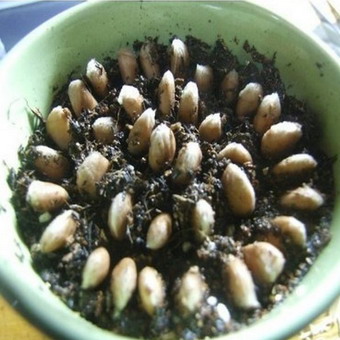
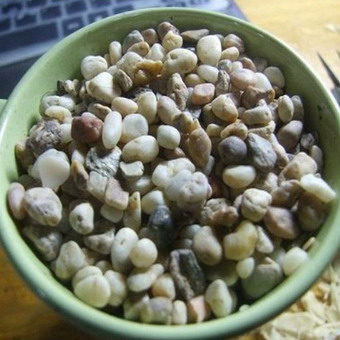
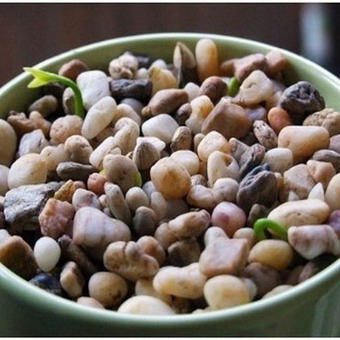


For this, large seeds are extracted from fresh, ripe lemons. Then they are immediately planted in a small container to a depth of 1.5-2 cm. The pots should have drainage holes, since citrus does not tolerate stagnant moisture well. A layer of drainage is laid at the bottom of the pot, fertile, fresh soil is poured on top. Several seeds can be planted in one container, this will make it possible to choose the largest and healthiest ones from the emerging seedlings. Moisten the soil before planting. After the seeds are buried, the pot is covered with foil. Watering the planted seeds is not recommended, as this can lead to their rotting. Planting a lemon from a seed is best done in a clay pot, since clay regulates the moisture of the soil. With an excess of moisture, it absorbs it, with a lack of moisture, it gives it to the plant.
How to grow a lemon from a seed at home
How to grow a lemon from a seed? The seeds are germinated at a temperature of 18-20 ° C. The first shoots will appear in 2-3 weeks. The film is removed after the second pair of leaves has formed. Seedlings are watered very carefully, as excess moisture will lead to their death. Young individuals are watered with warm, settled water. The first 2 months of feeding is not required. Grown plants are fed weekly with a solution and organic fertilizers.
Of the grown senses, only those that have the signs of a fruitful lemon are left. These features include the developed root system of the plant (this is evidenced by the insignificant distances between the buds on the stems), strong leaves, and the presence of thin shoots. Having chosen the most promising plants, they continue to work on their development.
What lemons grown from seed look like can be seen in the photo below:
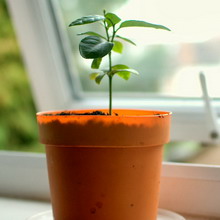 |
 |
 |
 |
 |
 |
How to transplant homemade lemon
How to transplant homemade lemon? Young lemons need to be transplanted regularly. The transplant is carried out as the root system develops. The tree is transplanted into a more spacious container. This work is done very carefully so as not to damage the root system.
As the tree grows, it begins to bush. To form a compact, correct crown, pinching of young shoots that have grown at the top is carried out. In addition, the leaves growing on the lateral shoots are pinched.
Planting and growing indoor lemon from a cuttings
How to grow homemade lemon from a cuttings? It is believed that this method of plant propagation is simpler than growing from a seed. In this case, the likelihood of a good yield of the tree increases. Planting a lemon cuttings can be done in the ground or in a pot. In late winter - early spring, cuttings of adult plants that have reached 10-15 years are chosen. In this case, branches of the 4th and 5th order are used. The shoot itself should be a little lignified. It is not recommended to take shoots of the current year, as they do not take root well. Several leaves should remain on the branch, the bottom sheet is removed, the rest are cut off by half. The top sheet remains intact. After planting, watering is carried out with settled water at room temperature, the cutting is covered with a glass jar on top to create a "greenhouse".
"Greenhouse" is removed after complete rooting of the plant. The planted stalk is placed in a lighted place. Water as the soil dries up. Transplanting a lemon grown in this way is carried out in the same way as transplanting with seed propagation. The tree begins to bloom and bear fruit in 2 years. In some cases, lemon blossoms start earlier than this. To prevent the tree from spending the supply of nutrients for premature flowering, it is recommended to pluck out the flowers that have appeared. The fruits will not form from them, and quite a lot of nutrients will be needed to maintain flowering. A year after planting the cuttings at the bottom and at the top of the trunk, excess shoots are removed.
Growing a lemon at home is not easy, since it is quite whimsical, demanding on light, moisture and air temperature. In addition, the tree does not tolerate changes in location and temperature changes. In both cases, the tree sheds its foliage, which negatively affects its fruiting. Therefore, when growing citrus, it is important to take into account all its features and provide optimal conditions for growth and development.
How to plant a lemon at home
In what soil to plant lemon at home? Potting soil can be purchased for indoor plants in the store or make it yourself. There are 2 options for such mixtures. In the first case, you will need sod land (2 hours), leaf land (1 hour), humus (0.5 hours), river sand (0.5 hours), crushed charcoal.
You can make a mixture of garden soil (2 cups), river sand (1 cup), humus (3 tablespoons), ash (1 tablespoon).
All components are mixed. To obtain a thick mass, add water.
To bring a rich harvest, periodic feeding is required. The amount of fertilizer is increased in the spring. In winter, the amount of dressing is minimized.
Any container is suitable for planting young plants. Trees that have reached 3 years of age are transplanted into wooden tubs made from soft trees. Planting lemon at home can be carried out at any time of the year, but February-March is considered the best time for this.























